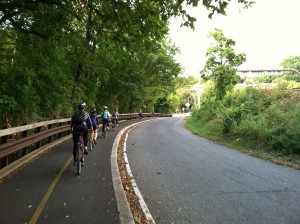
Philadelphia has been installing bike lanes for over a decade. They’re a big draw for its young residents.
You can’t drive through any major U.S. city now without spotting a bike lane. Separate spaces for bikes have surged in popularity, prompting cities across the country to widen their roads, and in some cases reduce car lanes, to accommodate for cyclists.
Bike lanes are typically five feet wide. They run adjacent to car lanes, generally traveling in the same direction as cars. They can next to the car lanes, separated by either by a parking lane or other barriers, and are most often in addition to sidewalks.
Based on data from seven major U.S. cities, the number of bike lane miles has increased about 50 percent from between 2006 and 2013, and cycling has increased about 100 percent, according to the National Association of Transportation Officials (NACTO).
Bike lanes also decrease risk for bicyclists. The same NACTO survey showed that an increase in bike lanes was correlated with a decrease in risk, which diminished by about 50 percent between 2006 and 2013.
Between 2000 and 2012, the number of commuters who rode their bicycles to work rose by 60 percent, according to the U.S. Census Bureau. The number of bicycle commuters rose from about 488,000 in 2000 to about 786,000 in 2012.
Despite the positive impact of bike lanes in the U.S., a number of factors are causing bike lane backlash, making some people weary of them and their implementation.
The cost of building a mile-long bike lane can range from $5,360 to more than $530,000, with an average cost of about $130,000, according to the UNC Highway Safety Research Center. Costs can add up when roads need to be widened, or curbs demolished and rebuilt.
Some critics, such as the MinnPost, say that bike lanes aren’t enough to keep bikers safe, especially when cyclists ride directly next to traffic. In cities like New York City, roads can’t be widened, which calls for either narrower bike lanes or the repurposing of parking spots, causing controversy.
Nevertheless, New York City is still a prime example of how bike lanes can decrease severe injury and death among cyclists. Between 2000 and 2014, there was a 72 percent decrease in the average risk experienced by cyclists in NYC, according to the NYC Department of Transportation.
Last Thursday, Denver Public Works decided to build more bike lanes within the city. On July 10, the city of Detroit received a grant to build more bike lanes in the downtown area.
Waterloo, Iowa, will be getting bike lanes, while plans for more bike lanes in Baltimore were announced in late June. At that time, plans for expanded bike lanes were put forth in Los Angeles.
But Baltimore’s first bike lanes were controversial. Residents were concerned that bike lanes made car lanes narrower and reduce the number of parking spots along the streets, according to City Lab.
Other cities, such as Boulder, Colorado, have removed bike lanes that were implemented at the expense of a car lane going both ways, according to the Denver Post.
A number of bike lane pilot programs have also failed, including those in downtown Boise, Idaho, and Memphis.
Cyclists’ major complain is that drivers don’t respect or lose respect for bike lanes. In Laredo, Texas, cyclists reported that drivers didn’t know what the lanes were for and sometimes drove in them, according to 8 KGNS. In Philadelphia, residents began parking in bike lanes and using them for valet services, according to Metro.
Still, cities are still going forth.
Bike lanes are protecting riders and seem to be increasing ridership in cities, which in turn could reduce congestion and pollution. The advocacy group Transportation Alternatives says that for streets to be safe and welcoming for bicycles, “the addition of bike lanes is essential. Dedicated space for cyclists educates all street users about a bicyclist’s right to the road, and creates a safer roadway by calming traffic.”
